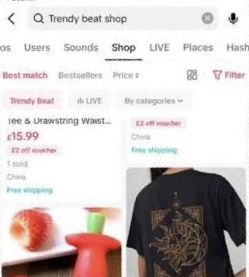TikTok is determined to make in-app shopping a thing, despite lukewarm response from Western audiences, as it seeks to capitalize on the massive popularity of the app, and in particular, its capacity to drive trends.
Which, of course, TikTok is inarguably able to do. Just ask the music industry, which now uses TikTok as a key marketing barometer, even changing artists’ song names to better align with TikTok trends.
And now, TikTok’s looking to use that insight to power its next eCommerce push, with a new in-app product showcase called ‘Trendy Beat’, which will display products made by TikTok itself.

As reported by The Financial Times:
“In recent weeks, UK users have begun to see a new shopping feature within the TikTok app called ‘Trendy Beat’, a section offering items that have proven popular on videos, such as tools to extract ear wax or brush off pet hair from clothing. All the items advertised are shipped from China, sold by a company registered in Singapore that’s owned by TikTok’s Beijing-based parent company ByteDance, according to filings and people familiar with the operations.”
The process injects TikTok itself into the consumer supply chain, in an effort to seemingly compete with fast-fashion sites like Shein and Temu.
“[The Project] utilises TikTok’s knowledge of items that are going viral on the app, allowing ByteDance to acquire or make those items itself, according to people with knowledge of the plan. The company then heavily promotes Trendy Beat products over rival sellers on TikTok, the people said. TikTok said the brand used a network of suppliers to produce items for its Trendy Beat offering.”
Which is a new approach to TikTok’s eCommerce efforts, essentially building its own product and sales pipeline, as opposed to relying on third party sellers to create their own TikTok shop.
The advantage for TikTok would be the capacity to tap into trending products faster, while also gleaning direct profit from any sales. It could also work as a habitual trigger – if TikTok can start promoting and selling more trending items direct in the app, that’ll give it more examples to highlight the potential of the same to brand partners, as it looks to convince them of the opportunities of in-app selling.
Despite various efforts, TikTok’s in-stream commerce push has thus far failed to gain steam in Western markets, even as it’s become the key income stream in the Chinese version of the app. TikTok’s now also seeing solid take-up of the same in other Asian markets, including Singapore, Malaysia, and Indonesia, but Western users are still hesitant to combine their social media and shopping experiences, preferring either physical shopping or dedicated apps.
But TikTok knows that there’s big potential here. Online shopping activity is steadily rising over time, while retail apps are also gaining traction, particularly those offering super cheap deals as a means to win over consumers, and better align them to their apps.
Indeed, Temu itself is currently making a big push in Western markets, with the company reportedly losing an average of $30 per order in the US, as it seeks to win people over with impossibly low deals on a wide range of random items.
The longer-term vision is that if they can win people over, that will shift consumer behaviors, and better align them to their apps. TikTok now appears to be taking a similar path, in using ridiculously low priced deals to lure consumers, in the hopes of changing the perception of the process.
Which could work. Again, broader online shopping trends point to rising potential, while younger generations are increasingly inclined to browse and shop online – and enticing them with crazy deals could make them more comfortable with the process.
That, eventually, could be the key to cementing shopping as a more common behavior for Western users in the app.



